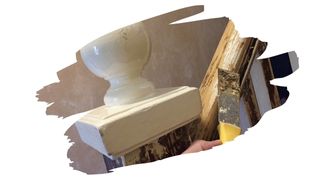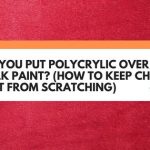When it comes to refinishing furniture, most paint stripping products will do a good job at breaking down old paint. But, there seems to be a little bit of a misconception (in the world of home DIY) of exactly what it is that paint strippers do.
You see, their job isn’t to completely dissolve away all traces of old paint. Instead, paint thinners simply thin out paint enough for you to remove it yourself.
But how much elbow grease is it really going to take for you to scrape wooden furniture clean? And do you always have to sand wood down after stripping it?
Well, in this post, you will learn why there’s sticky residue (after you’ve stripped off paint). You will also learn whether mineral spirits will do a better (or worse) job of stripping paint than paint thinners.
And keep reading to discover if sanding (after paint stripping) is a good idea for refinishing furniture.

This post may contain affiliate links to products that we receive a commission for (at no additional cost to you). Learn more here.
Why Is There Sticky Residue After Paint Stripping?
That sticky residue is actually oil left over from that old paint.
You see, while paint thinners can soften up a coat of paint, they do not dissolve it away completely. Instead, a solvent paint thinner simply thins out the paint, turning it into a sticky liquid.
That is why it can take a few rounds of paint stripping to really clean wood of old paint.
Related Post: 3 Simple Reasons Why Your Gloss Paint Is Not Drying (And How You Can Fix It)
So How Do You Remove That Leftover Residue After Paint Stripping?
Most paint thinners are basically a hodge-podge of different strong solvents all mixed together. This solvent combination is powerful enough to break down even long dried varnishes and stains.
So, if you want to get rid of that residue, simply apply more paint stripper, and scrape it off again. In fact, be prepared to do two to three rounds of paint stripping, to truly clean that surface.
Can You Simply Use Mineral Spirits To Remove Paint?
Well, mineral spirits, (aka White Spirit), is more of a mild degreaser. And it can break down oils, which is why it’s added to some lacquer thinner products.
But, on its own, it is not strong enough to really soften up a hard coat of paint. Instead, mineral spirits are the kind of solvent you would use to clean wet acrylic paint off a brush.
Stronger solvents, such as Acetone and Naphtha, will do a better job of removing hard dry paint, than mineral spirits.
Related Post: Will Mineral Spirits Be Enough To Remove Gel Stain?
And Do You Always Have To Start Sanding After Stripping Paint?
You can either sand off the paint or strip off the paint.
You see, stripping paint will leave behind a wet surface (and/or sometimes some residue). And this means that the surface is too soft (and gunky) for sandpaper to work effectively.
So, sanding is what you would do if you decided to forego the messiness of paint strippers altogether. However, if you plan on repainting that timber surface, then you will need to sand afterward.
And you’ll need to sand in-between each coat of primer, undercoat, and final coat. This is key if you want to leave behind a final smooth painted surface.
What About Painting After Stripping Paint? How Long Should I Wait Before I Get Started? Once you’ve removed that paint — and cleansed the surface of any leftover paint stripper — give it about 24 hours to dry.
To Wrap Up, Here Are The 3 Key Takeaways From This Post…
- 1). Paint thinners do exactly as their name suggests, they thin out hard dry paint. You will need to scrape off the paint to completely remove it.
- 2). If there is any sticky residue left after paint stripping, you’ll need to apply paint stripper again.
- 3). You may need to apply paint stripper some two or three times, to get back down to the bare wood.



